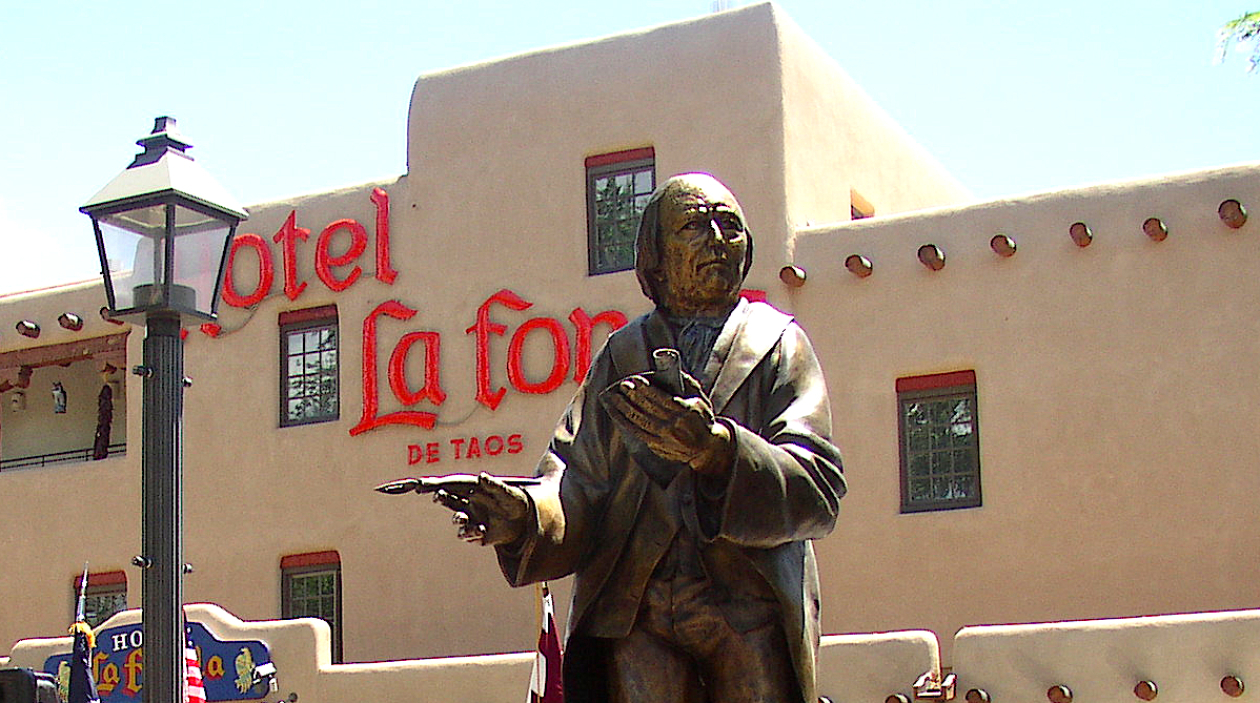This website is dedicated to the person and legacy of Padre Antonio Jose Martínez (1793-1867) who during his life was known as the Curade Taos (Priest of Taos). Upon his death in 1867, the NM Territorial Legislature called him La Honra de Su País (The Honor of His Homeland). He was orginally buried in his private chapel by his home in the center of Taos, and twenty-four years later his remains were removed to the “American Cemetery” on land that the Padre had donated for the burial of the Americans killed in the 1847 Uprising, located in what is now called Kit Carson Park. The encomium LA HONRA DE SU PAIS/THE HONOR OF HIS HOMELAND was inscribed on his upright gravestone as part of the epitaph. The NM State Legislature in 2004, under the leadership of Senator Carlos Cisneros, reprised that phrase in a unanimously passed resolution that provided funding for a public arts project. Two years later, that phrase became the title for the larger than life-sized bronze memorial of Padre Martinez sculpted by San Luis artist Huberto Maestas and erected in the Taos Plaza.
Antonio José was born along the Chama River in Abiquiu, avillage established in 1739 west of Santa Cruz (next to Española) along the RioGrande. When he was eleven, in 1804, he moved to Taos together with his parentsand younger siblings. At nineteen,Antonio José married Maria de La Luz Martinez, a distant cousin. Within a year, his young wife died as shewas giving birth to their daughter who was named for her mother.
The widower decided to study for the priesthood, left hisdaughter with her maternal grandparents, and made his way to the seminary inDurango where he excelled in his studies, especially canon (church) law andphilosophy. A major influence in his life was Padre Miguel Hidalgo, father ofthe Mexican nation. From his parish ofOur Lady of Sorrows and under the banner of Our Lady of Guadalupe, in 1810,Padre Hidalgo shouted for independence from Spain. Eleven years later, in 1821, a year before Antonio José wasordained a priest, Hidalgo’s shout for independence bore fruit. La Nueva España, including New Mexicoand all of what is today called the “southwest,” became La Republica deMéxico.
Shortly after his ordination, Padre Martinez returned to hisnative home in Taos. He was supposed tohave stayed for another year in Durango to obtain some pastoral experience andcontinue his theological studies. However,he was sickly—asthma (?)—so he returned to live for awhile at his parents’ homewhere some of his younger siblings were still living. The young Padre Martinezhelped the aging Franciscan priest who was the pastor of San Geronimo (St.Jerome) parish, the main church of Taos founded at the Indian Pueblo at thedawn of the seventeenth century. PadreMartinez also helped with baptisms, funerals, and wedding preparation at thechurch of Our Lady of Guadalupe at the Taos Plaza, about three miles to thesouth. Guadalupe was not yet its ownparish, but was still a mission dependent on the main church of San Geronimo.
After he recuperated from his illness, Padre Martinez wasassigned to a couple of parishes where he had the opportunity to show hisspecial love for the poor—at Tomé located south of Alburquerque and at theparish of Santo Tomás in Abiquiu where he had been baptized as an infant, andwhere his wife was buried and his daughter was living with hergrandparents. By 1825, the young Maríade La Luz also tragically died at the very young age of twelve, and within ayear, Padre Martinez was reassigned to be the priest in charge at Taos. This was his fondest hope, now realized.
This blog will explore in some detail—through biography,correspondence and other documentation– the forty-two years that PadreMartinez spent in Taos from 1826 until his death in 1867. I warmly invite you to MARK THIS BLOG AS ONEOF YOUR FAVORITES. Beinteractive, and share what especially intrigues you with others who may beinterested. Please help get the wordout. Invite others to track this blog.
Padre Martinez distinguished himself as a religious leader,educator, journalist, author, printer, publisher, rancher, lawyer andstatesman. The last decade of his life was clouded by serious controversy withhis new bishop, the Most Rev. Jean Baptiste Lamy. Martínez was a “liminal man” straddling the threshold of variouseras of New Mexican history–the Spanish period that lasted until 1821, theMexican period that lasted until 1846, and the American period that BenjaminRead called that most “transcendant epoch.” [Illustrated History of NewMexico, 1912]
